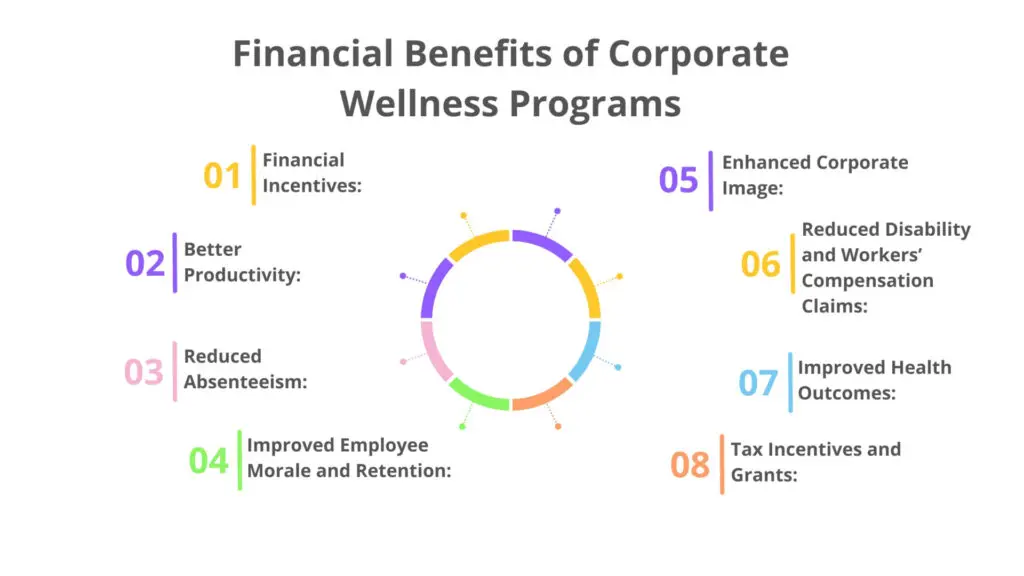
Introduction
Business leaders everywhere want the same two things: higher productivity and lower costs. One of the smartest (and most overlooked) ways to get there is by investing in employee wellness. One powerful strategy is understanding and maximizing the ROI of corporate wellness programs. These initiatives focus on enhancing the physical and mental well-being of employees, leading to increased performance, engagement, and a significant return on investment (ROI). This includes lower healthcare costs, reduced absenteeism, and a more motivated workforce.
Understanding the financial benefits and strategic importance of boosting the ROI of corporate wellness programs is crucial for any organization aiming to create a healthier, more productive workplace.
What is ROI in a Wellness Program?
ROI in a wellness program measures the financial returns associated with investments in employee health and well-being. These programs aim to cultivate a healthier workforce, resulting in tangible benefits like reduced healthcare costs and decreased absenteeism.
We calculate the ROI by quantifying the financial savings and benefits derived from these programs. This often includes reductions in medical expenses, fewer sick days, and increased employee productivity. Companies invest in fitness classes, mental health support, and nutrition counseling, anticipating that healthier employees will require less medical care and be more productive.
Beyond direct financial gains, ROI also encompasses indirect benefits such as improved employee morale, increased job satisfaction, and enhanced staff retention, all contributing to a positive and productive work environment. A well-designed wellness program focuses not only on short-term financial gains but also on the long-term benefits of a healthier, more engaged workforce.
The ROI of Corporate Wellness Programs: A Deep Dive
Corporate wellness programs have become essential tools for improving employee health and performance. These programs, which encompass physical fitness, mental health support, nutritional guidance, and stress management, have a significant financial, operational, and cultural impact on organizations. Let’s explore the various returns on investment.
Financial Benefits
- Reduced Healthcare Costs:
- Lower Insurance Premiums: Companies with effective wellness programs often see reduced health insurance premiums because of fewer claims from healthier employees.
- Decreased Medical Expenses: Wellness programs can help prevent or manage chronic diseases, leading to fewer doctor visits, treatments, and hospitalizations.
- Reduced Workers’ Compensation and Disability Costs:
- Fewer Injuries and Illnesses: Promoting healthy lifestyles reduces work-related injuries and illnesses, lowering workers’ compensation claims.
- Reduced Disability Leave: Healthier employees recover faster, minimizing disability leave and associated financial burdens.
Productivity Gains
- Reduced Absenteeism:
- Healthier Employees: Employees taking part in wellness programs take fewer sick days.
- Preventive Care: Proactive health management reduces the likelihood of severe health issues and subsequent absences.
- Reduced Presenteeism:
- Increased Focus and Energy: Wellness programs provide resources for nutrition, exercise, and stress management, enhancing employee focus and energy.
- Mental Health Support: Offering mental health resources helps employees manage stress and anxiety, boosting engagement and productivity.
Enhanced Morale and Retention
- Higher Job Satisfaction:
- Supportive Culture: A workplace that prioritizes employee health fosters a strong, supportive culture.
- Work-Life Balance: Wellness programs often include flexible work arrangements and mindfulness practices, improving work-life balance.
- Increased Employee Retention:
- Employee Loyalty: Employees who utilize wellness programs are more likely to stay with the company.
- Employer Attraction: Strong wellness programs attract top talent, reducing recruitment costs.
Enhanced Corporate Image and Reputation
- Employer of Choice:
- Talent Acquisition: Organizations with robust wellness programs attract health-conscious candidates.
- Positive Image: A reputation for caring about employee well-being enhances the company’s image.
- Corporate Social Responsibility (CSR):
- Community Engagement: Wellness programs that include community health initiatives show strong CSR.
- Sustainability Goals: Employee health aligns with broader sustainability and CSR objectives.
Long-Term Benefits
- Sustained Health Improvements:
- Chronic Disease Prevention: Ongoing wellness programs reduce chronic disease risks, leading to sustained healthcare cost reductions.
- Improved Lifestyle: Promoting healthy habits yields long-term benefits for employees and their families.
- Resilient Workforce:
- Adaptability: A healthy workforce is better equipped to handle change and challenges.
- Innovation and Creativity: Physical and mental well-being foster innovation and creativity.
Components of Effective Corporate Wellness Programs

- Physical Fitness Programs:
- On-site fitness centers and classes.
- Walking meetings and standing desks.
- Nutritional Support:
- Healthy snacks and cafeteria options.
- Nutrition counseling and workshops.
- Mental Health Resources:
- Employee Assistance Programs (EAPs).
- Mindfulness and meditation sessions.
- Preventive Health Measures:
- Health screenings and assessments.
- Vaccination drives.
- Education and Support Programs:
- Health education workshops and seminars.
- Peer support groups and virtual communities.
- Work-Life Balance Initiatives:
- Flexible work arrangements and remote work options.
- Parental leave and childcare support.
Measuring ROI in Corporate Wellness Programs
Measuring ROI involves quantifying the benefits of wellness programs.
- Key Metrics:
- Absenteeism rates.
- Employee productivity.
- Healthcare costs.
- Employee turnover.
- Data Collection Methods:
- Employee surveys.
- Health assessments.
- Performance reviews.
- Financial records.
- Data Analysis:
- Comparative analysis of pre- and post-program data.
- Cost-benefit analysis.
- Statistical analysis.
- Reporting.
Financial Advantages
Reduced healthcare costs.
- Increased productivity.
- Reduced absenteeism.
- Improved employee morale and retention.
- Enhanced corporate image.
- Reduced workers’ compensation claims.
- Tax incentives and grants.
Common Challenges and Best Practices
- Linking specific health outcomes to the program.
- Measuring intangible benefits.
- Maximizing employee participation.
- Targeting programs to the employee demographic.
- Utilizing technology to track and provide wellness solutions.
Conclusion
To realize the significant ROI of corporate wellness programs, organizations must prioritize investing in employee well-being. This investment leads to reduced healthcare costs, boosted productivity, and enhanced employee satisfaction, creating a positive and thriving workplace.
Author

Avidon Health is transforming how organizations promote healthier lifestyles through behavior change science and technology-driven coaching. Our mission is to empower individuals to achieve better health outcomes while driving measurable business success for our clients.
With over 20 years of expertise in health coaching and cognitive behavioral training, we’ve built a platform that delivers personalized, 1-to-1 well-being experiences at scale.
Today, organizations use Avidon to reimagine engagement, enhance health, and create lasting behavior change—making wellness more accessible, impactful, and results-driven.
